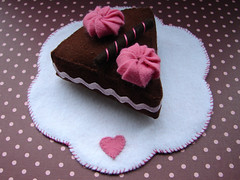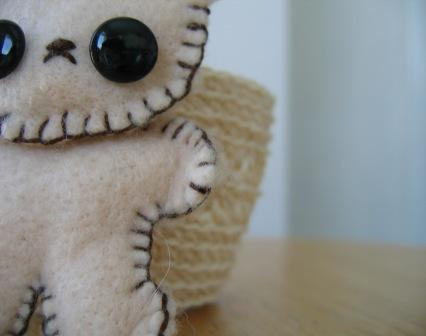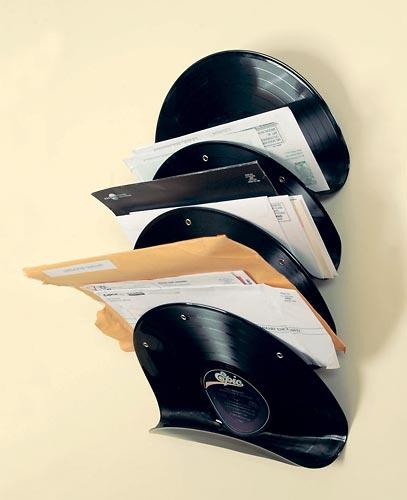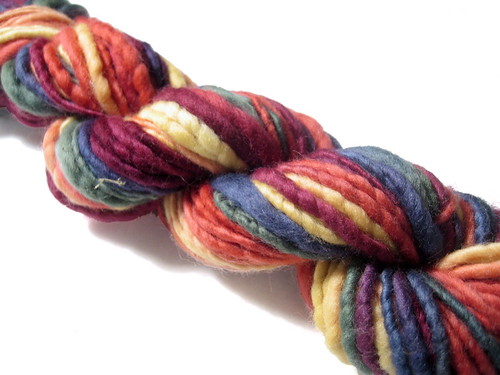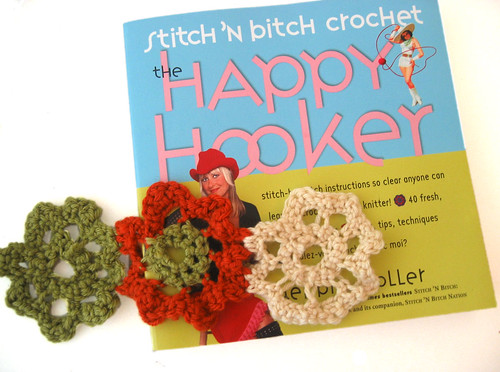Knitwiki
While bored at work, I stumbled upon this knitting resource that has potential to be truly amazing: Knit Wiki.
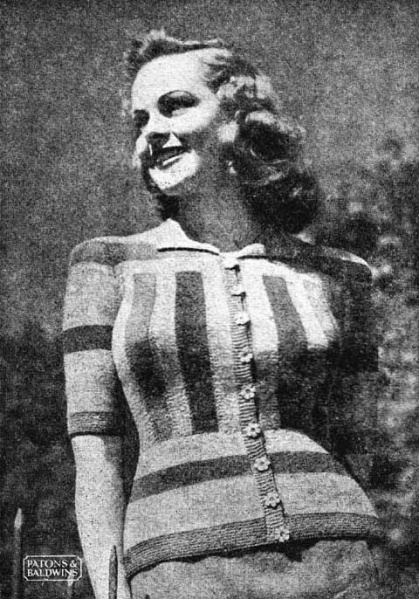
They already have a number of vintage patterns that are most likely public domain, though I'm not entirely sure as that requires they were published before 1923 or before 1963 and not resubmitted for copyright later. My favorites of their current patterns are the Lacy Gloves, the Tulip Gloves, and the Gwen Cardigan (above).
Also not to miss are the techniques, which are a quite handy and free resource for those just learning to knit, as well as those who need a refresher on a technique they don't commonly use.
But the one section I'm most excited about would have to be the listings for local yarn stores in the states and abroad. It's a sparse collection so far, excluding the Seattle-area (mwahahaha!), Australia, and Canada. If you have a bit of extra time, please do help add to the section. As any fellow yarnophile knows, the most exciting part of traveling is popping into the local yarn stores and picking up a number of goodies for their homeward-bound flight. Having shops in Rome listed would be handy right about now, but I'll have to make it my duty to do the grunt work while I'm there.
Eco-Friendly Yarns
In the past few months, I've noticed the term "eco-friendly" is on everyone's lips. From Oprah, to newspapers, to entire fashion magazine issues, "leaving a smaller footprint" is ringing across so quickly and loudly that I'm starting to fear it's just another seasonal fad. And the mis-information being bred by newspapers and fashion magazines (I don't have a TV so I can't comment on Oprah), is reaffirming my fears.
Take bamboo, which seems to be the runner-up for our holy grail to eco-friendly materials. It's easily renewable, requires minimal pesticides to grow, and is touted as antibacterial and non-allergenic. Bamboo flooring, furniture, and even fabrics and yarns are widely available--and will only become more so with steadily rising demand. But before you rush out and install bamboo flooring in your next home remodel, be aware that depending on the manufacturer, you may be doing more harm than good. These same adverse social impact and pesticide issues noted by TreeHugger apply to bamboo fibers (clothing and yarn), with the added caveat that dyes and/or chemicals needed for the dyes to bond on bamboo fibers may also be environmentally harmful. Furthermore, depending on the eco-consciousness of the fabric or yarn company in question, they may use harmful chemicals to ship the fibers or in order to keep mold or pests from hitching a ride overseas.
So, what's an eco-friendly consumer and knitter to do? Researching all the chemicals used in treating and dyeing different yarn fibers, as well as researching the fiber source and whether it adhered to fair-trade and fair worker treatment consumes valuable knitting time.
The most eco-friendly and failsafe way is to recycle your own yarn using unwanted sweaters. This helps to reduce post-consumer waste and prevent good materials from filling our landfills. And don't forget, recycling yarn is also much cheaper. With a good sense of touch and a little luck and persistence, you can secure high-quality yarn that rivals that $16 skein of cashmere-silk blend you longly petted last week in the local yarn store. For a great and well-detailed tutorial on recycling yarn from unwanted sweaters, check out How to Unravel a Sweater by Ashley Martineau.
And I do realize there are times when unraveling sweaters won't work, as well as the fact that there are times when a special splurge of brand-spanken new yarn off the shelf is in order. My ultimate goal for this site is to track down and research every major yarn out there that claims to be eco-friendly, taking into consideration dyes, processing, and foreign trade/labor policies each company employs. However, that's a heck of a lot of work for someone with a full-time job who will also soon traipse across Roman cobblestones for two months. So, in the meantime, I'm going to leave you with this non-exhaustive list of yarns that claim to be eco-friendly.
- Organic Cotton from Blue Sky Alpacas
- Euroflax from Louet North America
- Soysilk from South West Trading Company
- Twize from SWTC
- Bamboo from SWTC
- Hand Jive Knits fingering and nature's palette--natural dyes, certified organic
- La Lana's Wools natural dyes
- O-Wool Balance from Vermont Organic Fiber Co.
- Organik from The Fibre Company
- Savannah Bulky & DK from The Fibre Company
- FoxFibre cotton at Vreseis, Ltd.
- PickHemp wholesale yarns
The Masochistic Knitter
Hey, that would make a good book name. Mine! No stealing!
Here's a riddle for ya: What does a craft ninja do when said craft ninja has a boring non-craft-related job that consists of sitting at a blank computer screen and willing her coworkers to give her work? Answer: Read craft blogs! Lots of them! Especially ones pertaining to knitting!
During the many knitting blogs I read while bored at work, it came to my attention that a certain cover pattern from the most recent Vogue Knitting (Winter 2006) has been giving knitters a lot of headache. A lot of headache. Did I mention the headache involved with this capecho? No, there's some honest-to-god headache here. Some people have managed to tame it, while others merely worry . But the headache is there, hiding under the surface, whether they admit it or not. This ninja knows. Oh, this ninja knows.
And of course, once I saw two people mention their problems, I went and searched deeper and deeper into the Google depths, drinking up the horror stories like the latest high cholesterol episode of Desperate Housewives. Hell, I even went beyond Google and straight to Flickr and Craftster for my gluttonous desires.
You know, after watching all of this drama, I just can't refuse. Forget the fact that I have two Christmas gifts to finish for the Manflesh Mother. Forget the fact that--while close--I still haven't finished the Manflesh Mother's birthday present. Forget the fact that just last weekend I ordered yarn for knitting Forecast, the Airy Wrap-Around from Fitted Knits, and the American Beauty Rose Capelet from Knitting Over the Edge
(originally for a friend's wedding). Hell, forget the fact that I have a screenplay draft to finish, a trip to Rome to save for, three short stories to write, and a dog to feed. In my current drunken stupor, I'm gonna buy the yarn for this headache right now! Well...as soon as I figure out what yarn to buy....
Just one more reason why having a boring full-time job is a bad thing: too much money, and too much time to think about spending that money.
More Knits, Project Files, Resources
Japanese House of Craft
On a whirlwind "bachelor party," my friend was in town very briefly this weekend. So I made sure part of her bachelor party consisted of a visit to Uwajimaya Village, home to the greatest Japanese bookstore in the U.S.: Kinokuniya. Her eyes practically burst from her skull when she first entered. After a cursory inventory of the entire store, we both settled down on the floor in front of the craft section and proceeded to drool for the next hour.
I don't know when I started to fall in love with Japanese crafts. Because it's so hard to resist the Japanese's talent for combing cute with whimsy with simplicity, I'm sure I was blindsided the second I first saw a picture of some form of Japanese craft. What I do know is that when I first visited New York last winter, I made sure to visit Kinokuniya in Manhattan (near MoMA) and came home armed with my first three craft books. And then when I returned a few months later, I again made sure to visit Kinokuniya, and once again came home armed with more craft books. Somewhere along my multi-year journey into obsession (the obsession started way before visiting New York), I found out about the Seattle branch of Kinokuniya. However, I brushed it aside as I also knew it was an "extension" of Uwjimaya, and I was therefore convinced it was a tiny little outfit not worth my time. And then when I first saw the New York store, I became convinced that it was the only truth and that the Seattle store was a mere speck of dust in comparison.
If only I could time travel. I would do so just to smack my slightly younger self into sense. Not only is the Seattle store as good as the New York store, I'm now convinced it's bigger! At least, it certainly feels much more open and easier to navigate than the New York store. And at the very least, their inventories are a close match. Why, oh why, was I too snotty to visit before now? Oh, why!!! I guess it's a good thing I still live in Seattle and have the ability to make up for lost time.
Anyway, If you ever find yourself near any of the 21 oversees stores, make sure you visit. Japanese craft booklets are craft ninja porn, and Kinokuniya has no shortage of them. And speaking of craft ninja porn, I decided to compile a list of Japanese craft sites. Ittadakimasu!
Crafting Japanese, I Really Think So
- Japanese Knitting Basics: Simple translations to apply to your Japanese knitting patterns.
- Crafting Japanese: Japanese craft book resource that logs cover pictures with ISBNs.
- Flickr's Crafting in Japanese photo pool: for help with confusing instructions in Japanese craft books, but also used to show off finished items.
- Also on Flickr: Many more photos tagged with "Japanese craft book".
- CraftZine: Japanese craft links.
- Puppy Yarn: Patterns for purchase—mostly crochet.
- Knit Japan: Showcase of Japanese textile designers.
- Kinokuniya: Japanese bookstore of heavenly heaven.
- Uwajimaya: Seattle-area (and growing) Japanese supermarket complete with gifts and housewares.
Organic Flowers
To get those beautiful blooms you see in florist shops, the floral industry literally dips each flower in a concoction of pesticides. While there's no strong evidence that organic flowers are healthier for the recipient than flowers grown with pesticides, there is the questionable labor practices and environmental impact to take into consideration. The majority of these flowers are grown in Latin American and African countries that have lower chemical standards than the U.S., resulting in the use of nearly 20% of the chemicals banned in the U.S.
Organic Flower Retailers
Please note that I have not purchased from any of these retailers and cannot verify their validity.
- California Organic Flowers
- Diamond Organics
- Local Harvest
- Organic Boquet, read article from treehuger: "Organic Bouquet Delivers Carbon Neutral Flowers."
Bibliography and Further Reading
- Flower Confidential (read review)
- "Growers Say It with Organic Flowers", USA Today
- "Buy Organic Flowers Now", New American Dream
- "Valentine's Day 2007", Organic Consumers Association
- "Dutch Flower Growers Get Greener", treehugger, 2006.
- Pesticides, Wikipedia
Wood Types
While trying to figure out the differences between maple, and oak, and birch, I ran into a really handy list provided by a furniture store named Frontgate: Know Your Woods.
While I doubt I'll be buying furniture from any online store, the fact that someone, somewhere out there decided to compile this handy and simple list gives me a warm-fuzzy feeling akin to a mug of hot buttered rum. I've always wondered what the best woods for furniture were, and also what woods would make better ornate carvings. And now I know.
More Resources
Re-Creative
Today, my local newspaper ran an interview with Steve Dodds, author of the book Re-Creative: 50 Projects for Turning Found Items Into Contemporary Design. Dodds is a regular contributor to ReadyMade and has a penchant for collecting curb-side materials and giving them new life. Sound familiar?
The above article also includes a sidebar detailing the steps to make a "record album mail organizer." Not only is it a useful way to reuse records, but it's a change from the oh-so-three-years-ago record bowl or record cuff.
Awesome Product Photos—Light Boxes
Many people have asked how I take awesome photos. Some think I have amazing photo equipment and a high-end camera. But nothing could be further from the truth.
Let you tell me my dirty secret: PhotoShop, a Cannon PowerShot 410, and a $15 mini-tripod (or sometimes a stack of books). Oh, and a 5 year-old iBook.
So yes, the quality of my photos rely that much on PhotoShop, as well as my tripod. To get the background so bright and white, I need to start out with decent pictures and a lot of time and patience. My method is time-consuming and definitely not fool-proof—something that I really found out this week when one of the lights in my kitchen went out.
With the loss of that one tiny light bulb, I went from bright and crisp photos to dull and over-exposed looking atrocities by using my same PhotoShop methods. My biggest problem is I live in Seattle. And it's October—the beginning of our "second season." My apartment doesn't have this thing called "natural light" that most other parts of the country experience. I open the blinds in the morning, and my living room looks exactly like it did before I opened them. The only difference is that I can suddenly see the over-cast skies and rain-soaked porch.
Having crap photos and trying to sell what I create online just doesn't work. So my response? It's time to make a cheap light box for taking product photos.
The following three links are tutorials on making a light box. Read them, learn from them, use them. And then invest in cheap consumer-end photo-editing software, or download the open-source and free The GIMP. Save your extra craft pennies and don't bother buying PhotoShop. With a light box in hand, you won't need it.
Light Box Tutorials:
Meaty
Here's a couple of "meaty" links today, both from Monster Crochet.
A short, picture-filled post featuring Mixed Grilled Mats. Mats, as in table placemats!
And most importantly, a really good entry on Demystified Design. She goes quickly through her design process for creating crocheted "meat men." Totally awesome project, and uber-useful design information for someone wanting more than the basic yarn store pattern books.
Project: Learn to Crochet, Part II
When Debbie Stoller's Stich 'N Bitch first came out, I snapped it up for a friend who had expressed an interest in trying to learn to knit. Said friend came over to my apartment a few times to knit with me, and was doing quite well at learning. However, she seemed frustrated with her misshapen scarf.
I knew nothing of this book, nor how popular it would be soon after its release. All I knew was that I was looking for Christmas presents, my friend was trying to learn to knit, the University Bookstore was having a major one-day-sale for students, and the title was hilarious. A quick scan of the book showed detailed diagrams of stitches and how to execute them, light-hearted and interesting writing, and some fun beginner projects that might help ease my friend's frustration.
I'd love to tell you that this very book helped inspire my friend and coach her to learn knitting, but I don't think she's picked up a pair of needles since she scrapped her misshapen scarf over three years ago. However, this book wouldn't be so damn popular if it hasn't helped numerous others learn. If I had learned to knit when this book was around, I would been one of those others. Instead, I taught myself at the tender age of ten using the much less fun Knitter's Handbook, which I checked out from my local library for over two months before buying.
This weekend, I once again turned to Debbie Stoller and bought The Happy Hooker. This time, the recipient of this crochet manual was me. After a number of frustrating hours teaching myself to crochet with a hook in hand and a laptop on my stomach, I decided I not only wanted something that held my hand a little more in describing the movements of each stitch, but I also wanted something I could turn to with beginner projects. I'm a learn-as-I-go person, not content to do swatch after swatch before moving onto a project. And yes, sometimes this bites me in the butt. However, my interest is peaked more when working towards an actual project. Stoller's book fits the needs of both swatch-by-swatch learners and people like me, who tend to run straight off the cliff.
And in case you know nothing of Stoller's books and couldn't tell from the title, "The Happy Hooker" is quite snappy in delivery. Think of it as learning from your youngest aunt, who has more than one tattoo, rides a Harley, plays bass in a rock band, has a Ph.D in Early American Literature, and owns a closet full of merino yarn.
This book is an indisputable reference for the beginner at crochet. No prior knitting knowledge is required. Stoller includes a thorough section about types of yarns and how they relate to the art of crochet, diagrams of how to execute each stitch, pictures of stitch swatches so you can easily see if you're doing it right the first time around, and a section on how to read patterns.
And of course, the patterns themselves account for more than half the book. The patterns are designed with fun, fresh fashion in mind. No granny afghans or bulky, form-hiding sweaters here. There's a few funky scarves to start on, a pair of lacy fingerless gloves, a shawl, a caplet, a slew of hats, purses purses purses, flower pins, iPod cozies, and more yarn-intensive sweaters and a blanket or two. While the book is obviously aimed towards women, a few men's patterns are also included. You know; for your manflesh. The Happy Hooker alone will certainly guide the crochet beginner on through intermediate status with the numerous fresh projects and their varying degrees of challenge.
Now excuse me while I go back to my flower scarf. I need to finish learning to crochet so I can teach my manflesh. He was expressing interest in making those hyperbolic shapes.
More Crochet, Project Files, Resources
Project: Learn to Crochet
I had the brilliant idea of mixing crochet motifs with a regular ol' scarf today. Of course, the crochet motifs are the problem. That requires that I actually learn how to crochet.
I originally resisted the art of crochet for a long time, though it's something my mad-knitting cousin moved over to years and years ago. But I was never quite convinced. I never quite liked the projects I saw, the fabric results I saw. I still prefer a basic knitted fabric to a basic crochet fabric, but within this past year I've recently recognized the potential crochet also has—particularly in the form of motifs and lacy fabrics.
I've been using three websites to teach myself. The results are not excellent, but I think I'm figuring everything out. The biggest problem I'm having right now is finding a swatch online of a basic crocheted fabric to compare my results to. I think I'm doing it right, but how do I know?
It seems to me that crocheting is something like knitting's ugly step-sister. At least, when considering the popularity of the two. There are so many more beautiful patterns for knitwear out there, while crochet is still stuck in the dark ages of afghans and unflattering sweaters. Sure, it has its shawls and doilies, but I don't want shawls and doilies, damn it! I want—I dunno. But I don't want doilies, or shawls. Or afghans. God no, no afghans.
While I continue to wade through this new world of crochet, and hack through the remnants of horrid pattern designers who still haven't lost their day-jobs, feel free to browse the links I've been trying to learn on. It ain't easy for someone starting from scratch. If I find an easier way, I'll be sure to let you know. I'll also let you know if I find any awesome patterns that aren't doilies, shawls or afghans.
Resources:
- Annie's Attic: "Annie" has a ton of video files and diagrams on stitches, knitting and other fiber arts included.
- Stitch Diva Studios: They mainly sell patterns, but they have a great free tutorial section with step-by-step pictures instead of drawn diagrams. Just another way to reference something if Annie's isn't doing it for you.
- Crochet at About.com: I have a love/hate relationship with About.com. I hate the design and all the ads, but the information they have is generally pretty good. This section could be a lot better, but there aren't many good sources out there for crocheters on the vast and expansive interwebs.
More Crochet, Project Files, Resources
Selling Your Wares On Flickr
A lot of people—on Etsy and elsewhere—use Flickr to promote their handcrafted wares or other services. When you think about it, it's a great idea: Using a community-based photo sharing site to show pictures of your items and entice buyers to purchase them. Flickr's "photo pools" make this even easier in that you can create groups of people and share photos based on themes; "for sale", crafts, knitting, "I made it myself", and so on. However, Flickr clearly states the following in their community guidlines:
True to their word, they've been deleting personal accounts right and left. You can read about it in the Etsy forums, among many other craft venues. The ensuing witch hunts have also been noted over at Whipup, who sent an email requesting more clarification from the Flickr team. Flickr's response was posted in this blog post.
So far, photographers selling their services have been neglected in the witch hunts. While I can see why a photo sharing website would be reluctant to go after professional photographers, I've noticed many unscathed photographers on the site who are directly violating the user guidelines as much as any craftisan who advertises their wares via photos on Flickr. At this point in time, I feel like Flickr is unfairly playing favorites. If I hear otherwise in the future, I will certainly make a note of it on this blog.
Sources:
- Flickr Community Guidelines
- Etsy Forums: Waaah... my flickr account is gone! :(
- Whipup: Don’t use Flickr for commercial purposes
Further Reading:

